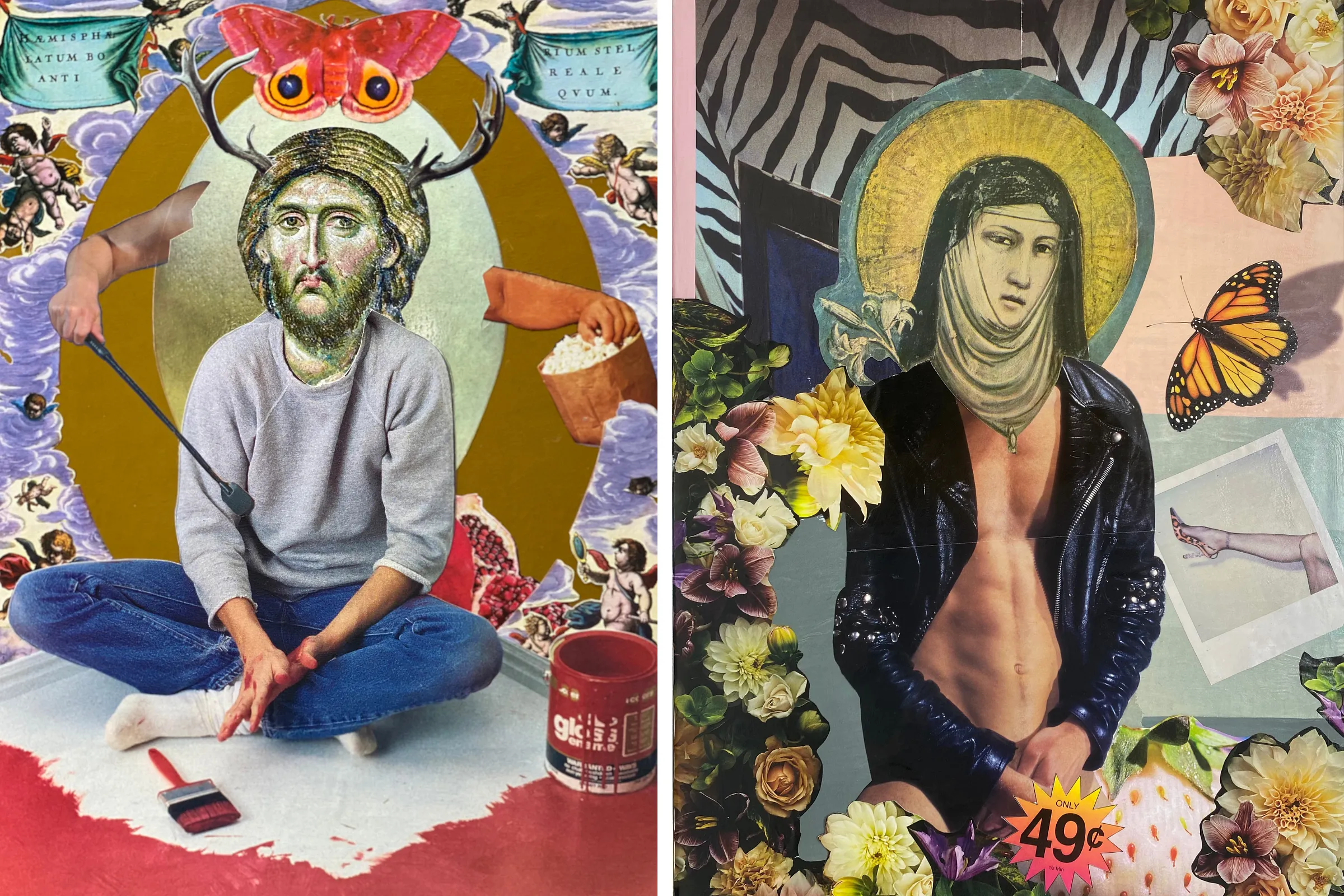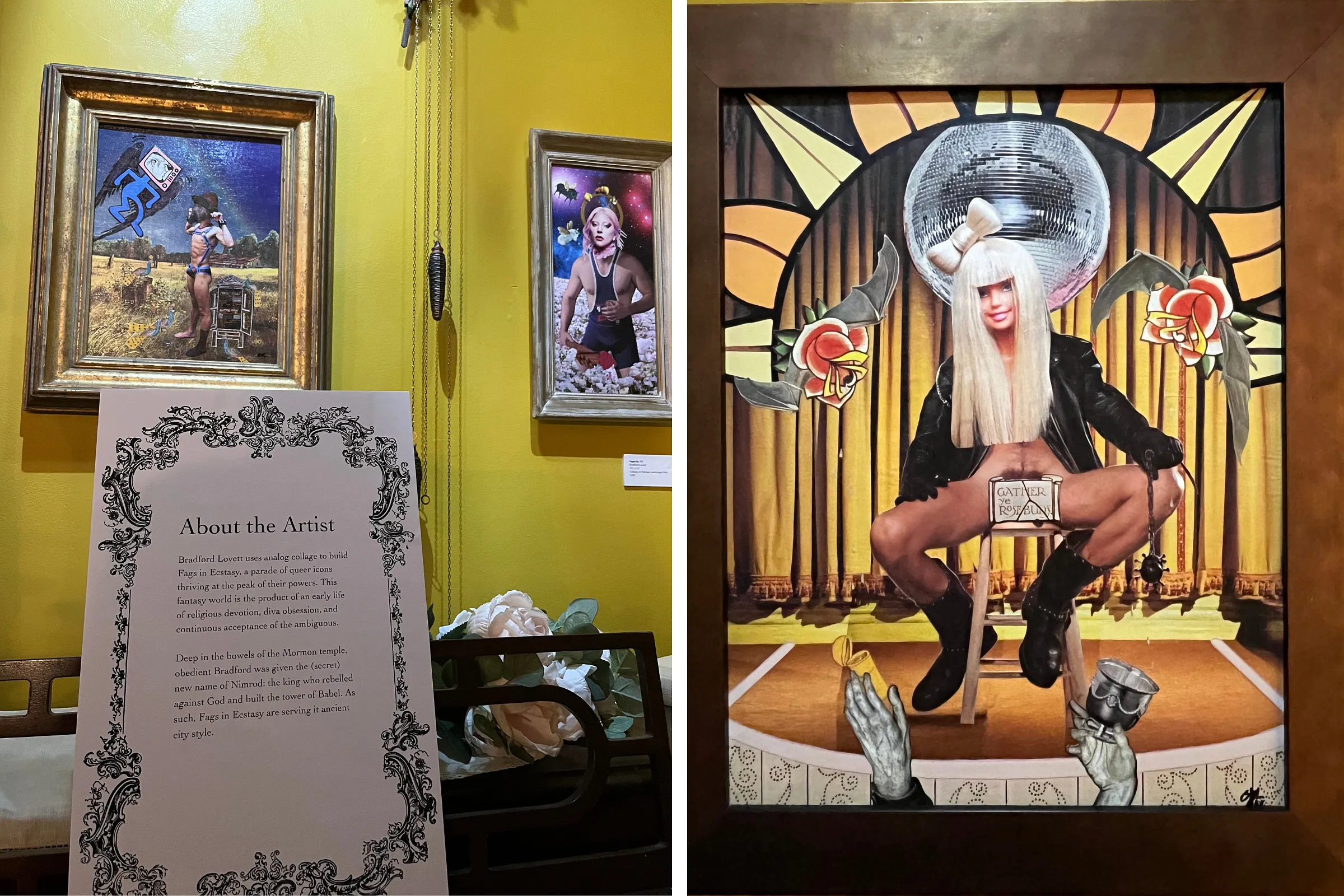Bradford Lovett: “Myths & Hymns”
The Parlour
Tulsa
March 21, 2024
In Bradford Lovett’s Gaythering at the Fam Farm, a disembodied hand reaches down from the sky with a pink donut in its fingers, almost making contact with jubilant penises rising from little floating Mario clouds. A dude with gold-plated pecs sits next to a man in white shirtsleeves who’s groaning over a cauldron full of bones, with two apocalyptic creatures in shiny red boots poised nearby and a slain Goliath in the foreground. A pair of cows holds space with a ballerina and a giant frosted cupcake as a witch-hatted Boy Scout rolls by on a recumbent wooden bike and a dragon carries a bound figure away over the peak of a falling-down barn.
These forms — felled, flirty, familiar, fantastical — are meticulously hand-cut and collaged by Lovett out of his vast collection of magazines, (porno)graphic ephemera and old Mormon art. (Originally from West Texas, he grew up in the Mormon church and spent time in Tulsa and Washington, D.C., before returning here recently.) The oil painting that’s the backdrop for this scene was a gift from a friend whose grandmother — “no friend to the queers,” said the friend — painted it. Lovett accepted the canvas as a challenge, queering this bucolic space with a population that includes both frolicsome fun and the real stuff of transformation. “I only use what I can find,” Lovett told me. “That’s part of the challenge.”
Gaythering at the Fam Farm was one of about a dozen pieces in Lovett’s recent show “Myths & Hymns,” which turned the refined walls of Trueson and Zia Daugherty’s home into a serious/delirious queer revolutionary romp. Large-scale scenes like this hung near smaller works the size of religious icons, all ornately framed, each remixing existing forms with a curious, loving, exuberant, literally iconoclastic hand.
“This show integrates a somewhat-tortured religious past with a vision for a queer future full of rowdy joy,” said Lovett’s artist statement. “Myths teach moral values, galvanize communities and commemorate icons past. These portraits are an imagined (previously unrecorded!) queer lineage: our saints and our elders. ‘Hymns’ acknowledges that sometimes, no matter how far we run or how much we grow, our brains are still programmed like the little religious kids we used to be. Happily, ‘a hymn is any song we choose to live our lives to.’”
With their gleefully disruptive juxtapositions, breathtaking skill with spatial perspective, and keenly balanced composition, his large pieces invite comparisons to Hieronymous Bosch and Kent Monkman. Lovett himself says Bruegel is a strong influence, with his affection for everyday things and his wide-angle scenes that, like Lovett’s, allow space to scan for small details and wonder about (or irreverently invent) relationships. At the same time, as he builds out a pantheon of characters to rival the endless genealogies (A begot B begot C, etc.) from the mythologies he was raised in, you can see Lovett’s inner kid self at work here, too.

A poster of a blue-jeaned Jesus “painted into a corner” — which hung in the artist’s childhood bedroom and was “meant to scare tweens,” Lovett told me — becomes a pagan, horned Christ, his sadness perhaps reflecting a longing for evolution in religion itself. Various figures in the show place women’s heads on the bodies of men — a way of working with painful experiences with conversion therapy growing up. (What in the embodied self is “wicked,” and what is “good”? Lovett’s art handle, Fags in Ecstasy, references the 1991 novel Mariette in Ecstasy, which wrestles with similar questions about the body as a vessel for dangerous possession and/or angelic transcendence.)
Almost a decade ago in Hyperallergic, Zachary Small argued that collage is “a quintessentially queer art form,” marked by “the construction of new worlds and identities.” Lovett’s work — diligently unearthing, untethering, aerating, playing, rearranging — gives a kaleidoscopic resurrection to these figures. “This fantasy world is the product of an early life of religious devotion, diva obsession, and continuous acceptance of the ambiguous,” Lovett’s statement explained. I’m still obsessed with his tattooed, bearded saint in blue pasties and pumps, his 49-cent Madonna, and his combat-booted Barbie with “naughty drips” (Lovett’s words) coming out of rosebuds on either side. But it’s that last item — continuous acceptance of the ambiguous — that resonates most deeply after spending time with his work.

“Artists are here to disturb the peace,” James Baldwin said. In the best art, a more complicated, more truthful sort of peace emerges in the aftermath. Lovett’s work accomplishes just that with sensitivity, humor, and painstaking detail. Tulsa’s Center for Queer Prairie Studies has been doing similar work of reclamation and imagination recently, bringing Oklahoma’s queer past out of historical erasure and envisioning a timeline in which queer lives are literally part of the picture. “Myths & Hymns” is a vital contribution to this evolving story.






